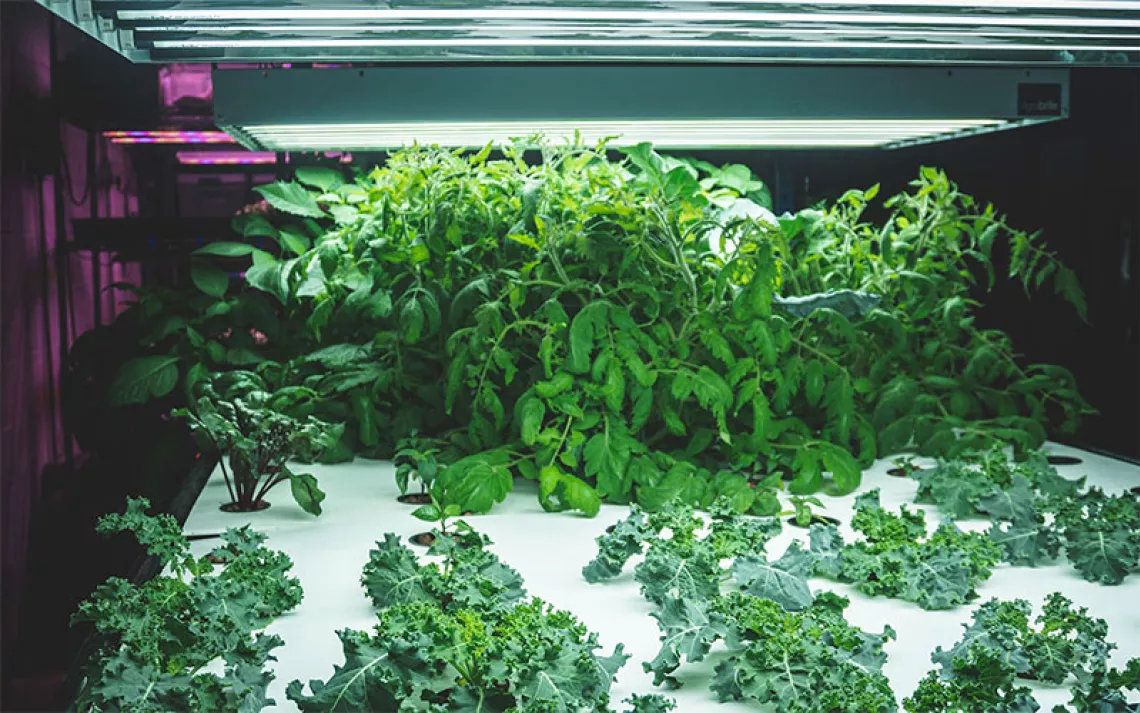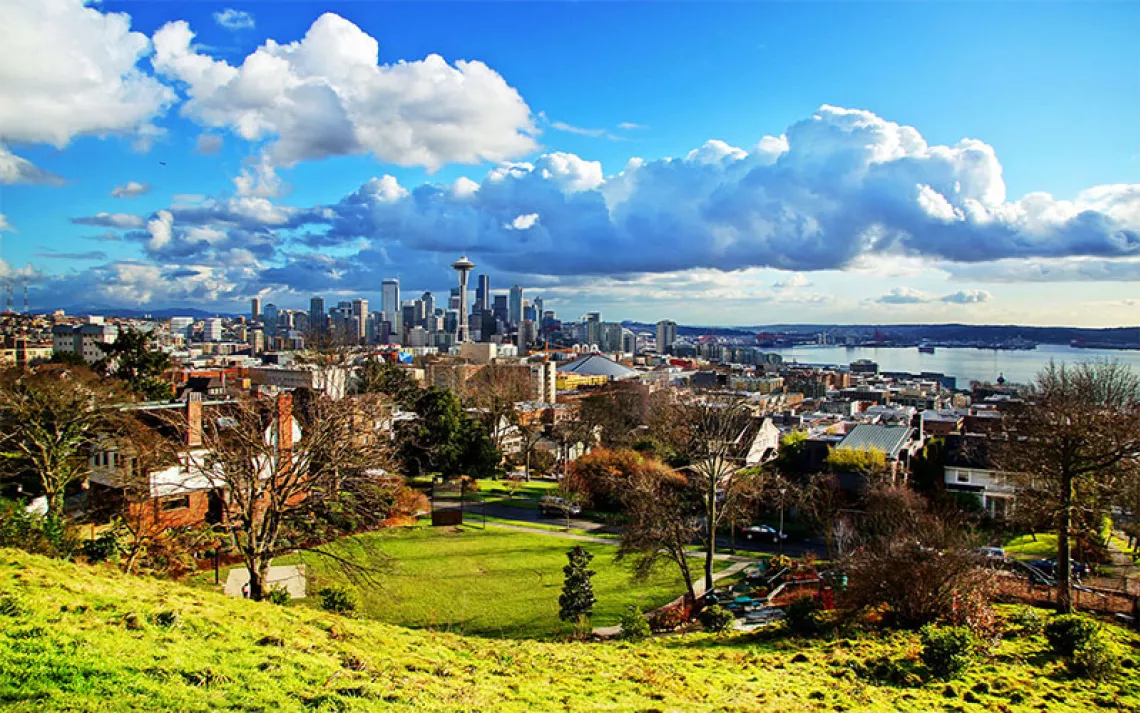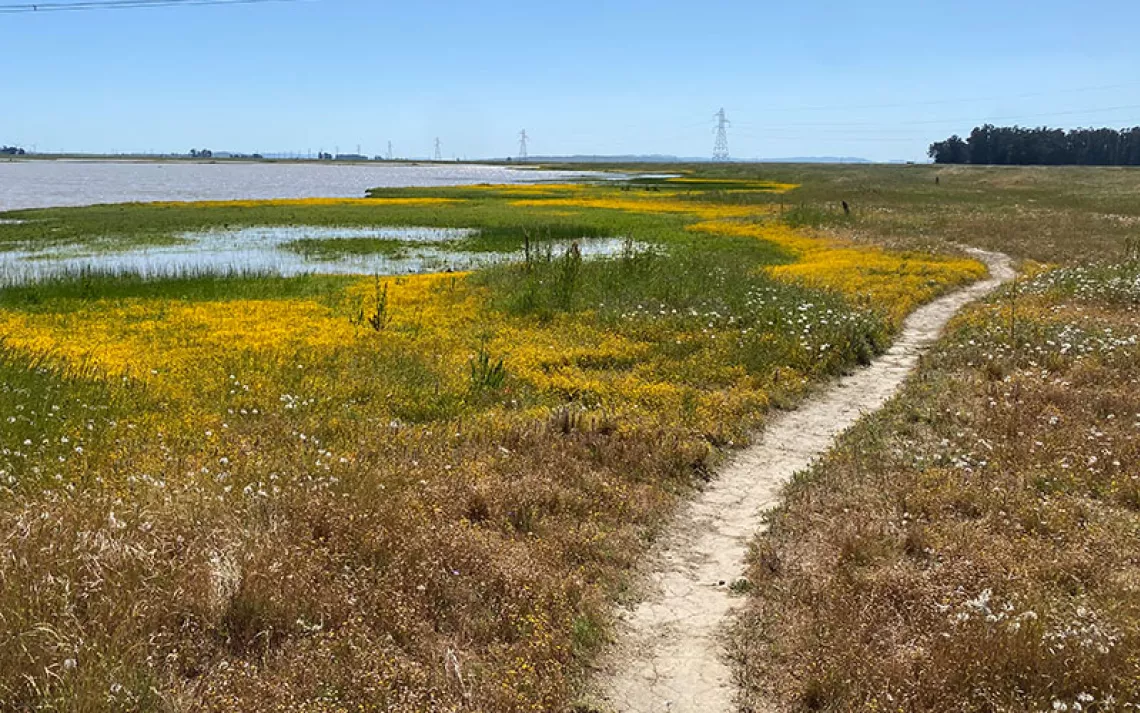Man About Towns
Dan Burden helps communities find their hearts

The spring night is dark; sudden rain lashes the windshield of the car; dense fog comes and goes, swirling trickily up from nowhere. For almost an hour it is hard to see if the slick, twisty mountain road ahead has any plan to its wanderings, any destination at all. At the wheel, Dan Burden--whom one of his clients calls "the Johnny Appleseed of livable communities"--drives forward as confidently as if he were entering his own neighborhood, and talks about his work and his vision of the slowly emerging, post-sprawl America.
Burden's enthusiasm for the 21st-century landscape ahead is strong and steadfast. He seems already a resident of a future that, for many, still only occasionally flickers into sight. People's optimism about improving their communities often wavers when they talk about the clutter, confusion, and congestion they see through their windshields. It falters again when they reach inside themselves to describe the absences sprawl imposes on their lives: It steals time, choice, and proximity to others--not just open space. We are not only farther away from schools and shops, from friends and neighbors, from fields and woods; more and more of each day is given over to a tense, effortful, unnourishing, and for now unavoidable in-betweenness. This townless, countryless, road-bound running around stretches us thin; our bodies are in motion--but what is there around us to anchor our hearts and minds? In the Atlanta area, for instance--cited in a recent study by urban planners at Detroit's Wayne State University as the most grievously sprawled region in the country--many suburban commuters now spend more than three hours in traffic each weekday. Once home, they can't stop, except to switch hats, becoming family taxi drivers--fetching children and running errands. As Dan Burden often reminds people, the average American family, in Atlanta and nationally, makes 14 car trips a day. More and more time in the car, which at first seemed a small price to pay for pleasant suburban homes, becomes almost intolerable when it occupies up to 30 hours and requires some 90 drives each week. People are no longer driving, they're driven. More open space--25,000 square miles--got converted to urban uses between 1993 and 1997 than in the entire decade of the 1980s.
Under these circumstances, it's hard to stay focused on the genuine awakening that has paralleled this worsening of America. In the 1990s, new and newly rediscovered ways of building non-sprawl neighborhoods began to get more attention. They go by many names: smart growth, sustainable development, community building, town building, place-based conservation, community-based planning, livable communities, and the new urbanism.
Burden is part of the suddenly arrived profession that promotes these new kinds of communities. Perhaps half a dozen groups of itinerant designers and facilitators are now crisscrossing the country conducting workshops with local residents. They're exploring the possibilities of changing streets and buildings in ways that would add pleasure and reassurance to towns, making it easier for people to meet up with one another and stay in touch with each other's lives.
Four years ago, Burden set up a nonprofit called Walkable Communities with his wife, Lys, who answers the phones at their home/office in Florida. Since then, he has worked with almost a thousand communities across 41 states, from small towns like Stevensville, Montana (population 1,000), to neighborhoods in Honolulu, Los Angeles, Phoenix, Dallas, Chicago, Detroit, and Orlando. Does a city become more lovable as it becomes more livable? Can we find a balance between cars and people? What about the even trickier balance between land and cars and people? Can developers and local officials move from blueprints to "greenprints," so that a town's growth plans add green space to people's lives, instead of taking it away? These are a few of the many questions that Burden tackles with his clients to help them fight sprawl from within.
These days the road is probably the only place where it's possible to have a long, contemplative chat with Burden. On his way to a town meeting in central California, we speak about the excitement of people who are ready to work together for change, and how a spark first ignited in him. After college and four years in the Navy, Burden, Lys (who'd been his high school sweetheart), and another couple spent three years bicycling from Alaska to Argentina. "The long trip south was when I first began to feel connected to life, and life processes," Burden says. "The big surprise was that, in every place we passed through, danger was always perceived as being elsewhere. Close by, but elsewhere. No matter what kind of community or what part of the countryside we landed in for the night--it could be prosperous and smiling, or desperately impoverished--kindly people, always aghast, invariably asked us the same two questions about where we'd come from and where we were headed: 'You came through there? You're going there?'"
You could tell where here ended and there began, by mapping where the fear line fell between what people felt they could trust and what they had no sympathy for. Burden thinks there's probably a similar sprawl line in many of us: The faster communities change, the more people start pulling back into a safe zone that sometimes shrinks down till it's no larger than the few streets they know best, or maybe only as big as their own house and yard. Almost everything else becomes a there, or at best an in-between-- a compromised, diminished, untrustworthy, no-longer-cherished landscape. All that may be changing, however. Burden thinks the United States is in the midst of a historic transition period that will occupy the next 10 or 15 years. At the end of that time, many of us--perhaps most of us--will open our front doors to dramatically more sustainable and pleasurable neighborhoods. "What's new, and still largely invisible, is the dismay many people experience when they see something going badly wrong in their communities," Burden says. "It can hit so sharply they simply can't walk away from it. I'd call this a ripening, as well as a worsening--a new readiness to take charge of a town's future."
But the process of change, he thinks, necessarily takes quite a while--we're tied, for instance, to certain zoning regulations and investment decisions. "I tell my audiences that Schopenhauer long ago defined the three stages all new ideas go through: ridicule, violent opposition, and acceptance," says Burden. "I've never yet seen a single step skipped in any community."
Peering through the fog, Burden says that if he had to adopt a colorful nickname, "Johnny Applebloom" would come closer than "Appleseed." "Seeds and sprouting--all that precedes me. The fruit and the harvest will arrive sometime after I've left town." Towns on the rebound often have to go through several local elections to find a new city manager who believes in better days ahead. They also need what he calls a "sparkplug," someone either in or out of government for whom recapturing community has become a full-time passion. When Burden arrives, towns have usually worked hard by themselves for a year or more. "Then they are ready for a week or so of clean thinking about their own future," Burden says.
In every community he visits, Burden instantly and unobtrusively sets up a nonauthoritarian atmosphere: He makes a point of wearing disarmingly colorful shirts and bold, goofy ties. He also sports a jaunty, Captain Kangaroo-size mustache. It's more than mood-making; it's a point that gets across without words. Burden doesn't say, "Stop looking for experts and leaders, and listen to yourselves." Still, in the whirlwind of conversations he convenes, towns redesign themselves.
The process generally starts with Burden assembling and listening to a variety of small "focus groups": police officers, social-service providers, firefighters, city council members, property owners, and developers. Once people start talking candidly among their peers, Burden says, they can then talk more easily with each other in public. In these warm-up meetings, he hears some of the same things in every town. Nationally, for example, several generations of firefighters have grown up thinking they can't get to fires on time except over 40-foot-wide, suburban-style streets (Burden's laptop has a video of fire engines racing to a fire through 18-foot streets). Some people will inevitably resist talk of neighborhood-building, insisting that the only new housing that either lenders or buyers are interested in is standard subdivision with large-lot single-family homes.
With so much potential contentiousness, how does cooperation start? It can begin when a town asks why it has been doing things to harm itself. But getting from dissatisfaction to action seems to depend on an awareness of both what to do differently and how to initiate the change. That's what Burden's presentations are all about--what turnarounds American cities have accomplished. "Cities are an invention to maximize the exchange of goods, culture, friendship, ideas, and knowledge, and to minimize travel," he says, quoting Australian transportation reformer David Engwicht. Burden points to the traffic-calming treatments that Americans are importing from successful efforts in Europe and Australia. These include the "boulevarding" of busy streets, adding landscaped medians and trees that slow traffic by reminding drivers they have entered a place that people care about; "road dieting," which means shrinking a four-lane road back down to two-lane size; and "bulbouts," intersections you can walk across more easily because the sidewalks get wider as they approach the corner.
In his presentation, Burden often uses the physics of traffic movements to explain why a small roundabout can work more smoothly than a standard, four-way intersection: In a roundabout, there are only 8 "conflict points" where cars moving in different directions might potentially collide with one another; a four-way intersection has 32 conflict points. He also notes that even intense police ticketing blitzes can't reduce speeds on roads whose wide-lane straightaways have already announced to drivers that it's okay to go fast. One case among many: two similar, nondescript roads Burden worked on in University Place, in Tacoma, Washington, where people routinely drove 44 miles an hour, despite posted speed limits of 35. When local police wrote 300 traffic tickets in two weeks on one of the roads, speeds there dropped to 40--but only temporarily. When the neighborhood narrowed the other road and added bike lanes, sidewalks, and trees, speeds immediately dropped to 31 miles an hour, and--without police work--have stayed that way.
But these facts and studies are only the quantifiable half of what Burden passes along every time he starts talking with and listening to a town. Working with Spanish-born architect and planner Ram—n Trias, Burden has been quietly reinventing a critical piece of democracy--creating a 21st-century version of the 19th-century town meeting. Without calling attention to it, he sets up a new forum of public decision-making that moves people away from the poisoned, argumentative, frustrating debates so common at most public hearings--where people almost always are merely responding to someone else's predetermined ideas for change.
Echoing a famous old children's story, Burden sometimes calls his new kind of town get-together "stone soup." In the story, three hungry soldiers trick a group of suspicious villagers into acting with generosity, cooperation, and compassion. When the villagers refuse to feed them, the soldiers reply that they will feast the entire village on a dish fit for a king: stone soup. All they need is an enormous kettle filled with water, and a fire. When the villagers bring these, the soldiers ceremoniously drop in a stone. Soon the villagers watch the soldiers taste the broth. "Excellent," says the leader. "Of course, it would taste much better with some carrots--that way it would surpass even the soup we served the king." A villager scurries off and returns with some carrots. The soldiers then coax potatoes, beef, and all sorts of other goodies from the excited villagers, and the small generous gestures start to add up. "And to think," the villagers say, "that all this bounty came only from a stone!"
Burden evokes a similar generosity in the towns he visits. His trick is to offer such an enticing smorgasbord of chances to join in that everyone feels personally invited and responsible for the outcome. For people who like small gatherings, he convenes the focus groups. For those who like lectures, there is his fact-filled slide show. And he often adds a town vote on priorities, where people walk to the front of the room armed with old-fashioned colored dots that they stick on lists they've just generated. Sometimes the priorities are specific: Citizens want to preserve a historic building or calm traffic on a particular street. Other times they simply agree that they want to create a sense of pride and community, or some kind of clean and pleasing public space. In Oyster Bay, Long Island, for example, residents decided that they were finally ready to take advantage of their finest natural asset. "This is an example of a town that couldn't mobilize or create a focus for itself," says Burden. "But when they sat down together they realized that what they wanted to do was link their downtown to the waterfront." The town had historically had its back turned to the water, but the more people talked the more it became clear that they all wanted to face the future by creating beautiful public spaces on the waterfront.
In addition to colored dots, Burden uses the latest high-tech gadgets. A former National Geographic photographer, he carries a digital camera on his walking tours of the cities he's been invited to. Since his slide shows are now computerized "PowerPoint" presentations, he can easily insert photos of things he's seen around town that very afternoon. And he includes same-day shots of people who've turned up for just-barely-adjourned focus groups.
Burden also conducts "walking audits," guided tours of a neighborhood that let people see for themselves how pleasant or arduous it is to make their way around town. At the heart of everything is the "design workshop," an afternoon-long session on the second or third day of a Burden visit where groups of seven or eight people sit around tables and rethink and redraw the shape of their town. The sum of all these activities constitutes a process Burden calls a "charrette," or sometimes a "vision charrette."
"Charrette," which means "little cart" in French, is an old architectural term that originally was a joking way of talking about students working feverishly up to the last moment, even inside the small wagons carting them off to their final exams. By extension, it's become a word for a concentrated, team approach to a design project. In recent years new-urbanist architects have used the charrette as a vehicle for bringing their design concepts to larger audiences.
Burden and Trias have given the charrette a twist-the professionals on hand generally climb down off the podium. They are conversation starters and interested friends, not authorities. This mental jujitsu outwits the pessimism that Burden says is often lodged in many communities-even after they've started bouncing back from despair. Years of watching things go sour, accompanied by years of not being able to talk productively about the situation, have left behind fears, suspicion, and a widespread set of assumptions including: People can't agree; they don't know what to do; they have to rely solely on experts for ideas on how to improve town life.
The charrette gives a community a taste of what it's like to nourish itself again. It's an extended, four- or five-day-long moment that's part revitalization, part revivalism. As people pool their energies, there's no time to stop and think about the alliances that never existed before, at least not for the past generation. "It's always a lot of fun," says Burden, "when people work in concert toward a dream and suddenly realize they actually like all those rotten people they've been arguing with for the past ten years."
Burden fondly recalls a charrette that brought environmentalists, business people, and farmers together in Willits, California. For more than 30 years, says Burden, townspeople had been debating whether to build a bypass that would shift the heavily traveled Highway 101 traffic away from the main street of town. The California Department of Transportation (Caltrans) wanted to build a massive bypass. Environmentalists and farmers were against the plan, however, because they opposed the destruction of agricultural areas or wetlands. Business people were worried that a bypass would kill commerce on the main street.
"In a two-day period we were able to get all these groups, which had not been talking to each other, to come to a consensus on a vision for the town," says Burden. "They agreed that they needed a bypass but it wouldn't be what Caltrans wanted. It would be very sensitive to the outlying area, with an entry point on either end of town that had roundabouts that would slow traffic. Most important, it would only be two lanes." Caltrans wasn't thrilled with the two-lane proposal but finally came around, and even committed to fixing the main street through Willits, returning it to the walkable, quiet, commerce-friendly place it once was. "The plan addressed everybody's needs," says Burden. "It got the big trucks out of town, it eliminated a lot of noise, and it didn't produce new problems such as sprawl."
What happens when people learn to listen again to themselves and to each other? Thoughtfulness, once evoked, can lead to healing. People begin to sense common purposes and exchange friendship, ideas, and knowledge. The high point of the charrette arrives when people share their designs for a better community. Then it's time for Dan Burden to hit the road again. Another town has found a way to hear its own heartbeat.
 The Magazine of The Sierra Club
The Magazine of The Sierra Club



